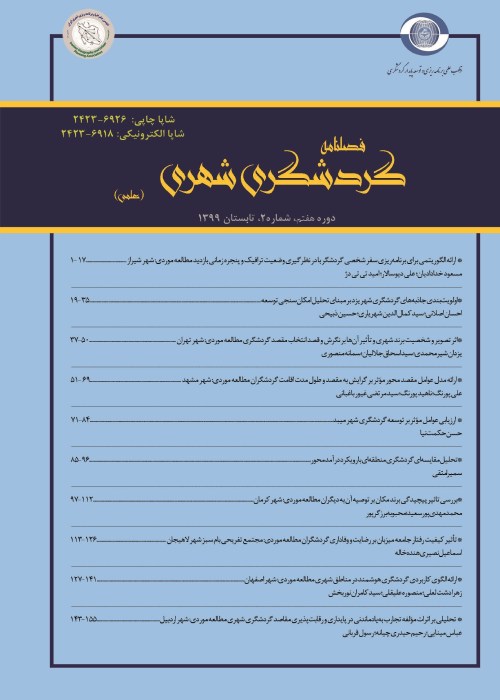Comparative analysis of spatial differences in leisure time in metropolitan areas of Tehran (Case study: areas 19 and 22)
Leisure is defined in any way and concept, it is one of the indicators of lifestyle and people's lifestyle usually shows itself in leisure. The level of people's access to material and cultural resources, including education, can determine their social and economic status and, along with personal characteristics such as gender and age, create a certain type of lifestyle for them and determine the amount and fruition of their leisure facilities. In the meantime, understanding the current situation and the spatial pattern governing the leisure activities of citizens and leisure priorities in the form of categories and ways of spending leisure time and barriers to achieving them will be very important. Therefore, in this framework, the present study tries to study the relationship between independent variables such as age, gender, education and income in the dependent variable of leisure time, to study and comparative knowledge of the type and manner of leisure time in the study areas to prioritize leisure priorities and barriers. In the continuation of this research, it tried to study the spatial analysis of leisure time by presenting the level of fruition and non- fruition of areas of leisure uses both from the point of view of leisure specialists and experts and from the point of view of access levels to a suitable spatial model. In this regard, create a comparative analysis in order to identify the spatial differences of leisure time in the desired areas, one of which is the middle texture and the other as the new urban texture.
The research method in this research is descriptive-analytical and inferential and its type is applied. Using the documentary method, conceptual and theoretical dimensions of the subject, different indicators related to leisure time have been studied. Both quantitative and qualitative methods have been used to analyze the data. SPSS software and Pearson correlation and analysis of variance were used to perform statistical analysis and correlation of variables. Other software in the study areas is Eexcel. The multi-criteria decision model and its combination with hierarchical analysis in the GIS environment and the effective Expert Choice software have also been used to obtain a spatial pattern governing how leisure is spent.
The results show that the amount of leisure time spent among men living in region 22 (2.90) was higher than women (2.81), which is higher in region 19 among men living in region (3.61). It was from women (3.53). In examining the relationship between age, education level and income (independent variables) with leisure time (dependent variable) in the study areas, it should be noted that the highest correlation between independent variables and dependent variable in region 22 is education variable with 0.319 . Similarly, the income variable with 0.226 and the age variable with 0.156 are in the next ranks. Therefore, the results of correlation coefficient show that there is a positive and direct relationship between the variables of age, education and income with leisure time. However, the highest correlation between independent variables and dependent variable in region 19 is related to income variable with 0.651. Similarly, the education variable with 0.522 and the age variable with 0.299 are in the next ranks. In the following, a list of types of leisure time and existing barriers to spending leisure time in the extracted areas were prepared in the form of questionnaires and analyzed separately in order to provide points and rankings of the extracted materials. Then, it was tried to provide access to leisure uses in the form of maps so that in addition to determining the quality of access and their extent fruition of recreational uses, the needs of the study areas can be determined for each of these major uses. But the work does not end here, but using the opinion of relevant experts and effective models and software, an attempt was made to analyze the fruition availability and non- fruition of areas.
The results of one-way analysis of variance test in the study areas showed that there is a statistically significant difference between the gender with the way they spend their leisure time in both areas. Leisure time spent among men and women in the study areas showed that the amount of leisure time spent among men living in the areas was more than women. The highest correlation between independent and dependent variables in region 22 includes education variable with 0.319, income variable with 0.226 and age variable with 0.156. But the highest correlation between independent and dependent variables in region 19 includes income variable with 0.651, education variable with 0.522 and age variable with 0.299, respectively. Therefore, according to the results of the models in regions 19 and 22, it was found that there is a significant and positive relationship between the variables of age, education and income with the amount of leisure time spent. However, regarding the way of spending leisure time and leisure spaces in both areas, it should be noted that it has both collective and public methods and inactive private and home methods, with the difference that the growth of recreation is more and more in private like cyberspace, using Internet has been higher in District 19 than in District 22. Finally, the results of residents' access to a variety of leisure spaces indicate that District 22 has more leisure uses than District 19. However, it should be noted that despite the fact that District 22 has more leisure uses, research has shown that the amount of leisure time among men and women in District 19 is higher than in District 22, and as mentioned in, this is due to the prevailing growth of recreation more than ever in solitude.
- حق عضویت دریافتی صرف حمایت از نشریات عضو و نگهداری، تکمیل و توسعه مگیران میشود.
- پرداخت حق اشتراک و دانلود مقالات اجازه بازنشر آن در سایر رسانههای چاپی و دیجیتال را به کاربر نمیدهد.


